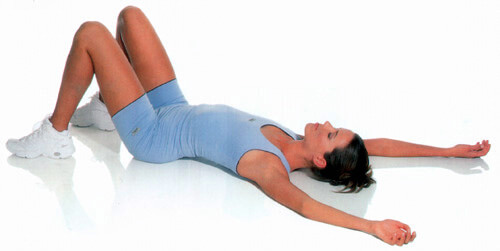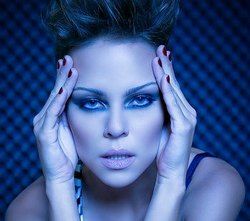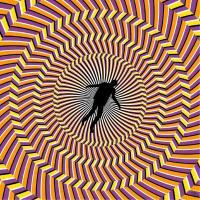Stroke: symptoms, first signs in women, in older men
Content
- What is a stroke
- What can cause a hemorrhagic stroke
- Causes of ischemic stroke
- Provoking factors
- Symptoms
- Periods and stages of the disease
- Diagnostics
- Treatment
- Prophylaxis
- Recovery period
- Related Videos
What is a stroke
A stroke is caused by an interruption in the blood supply to any part of the brain. The consequences are quite unpleasant, sometimes disastrous. The concept of a cerebral stroke is understood as the obstructed blood supply and its flow through the cerebral vessels. The reasons can be different, more often they happen:
- blockage of important arteries. The result is severe oxygen deficiency in the brain region and lack of nutrient intake. This reason is called "ischemic", it occurs out of 10 cases 7 times;
- rupture of the vessel. The consequence is a cerebral hemorrhage with the subsequent formation of a hematoma. Such a stroke is called hemorrhagic.
Hemorrhagic stroke has a more severe form of manifestation, and carries a serious danger to the body.
What can cause a hemorrhagic stroke
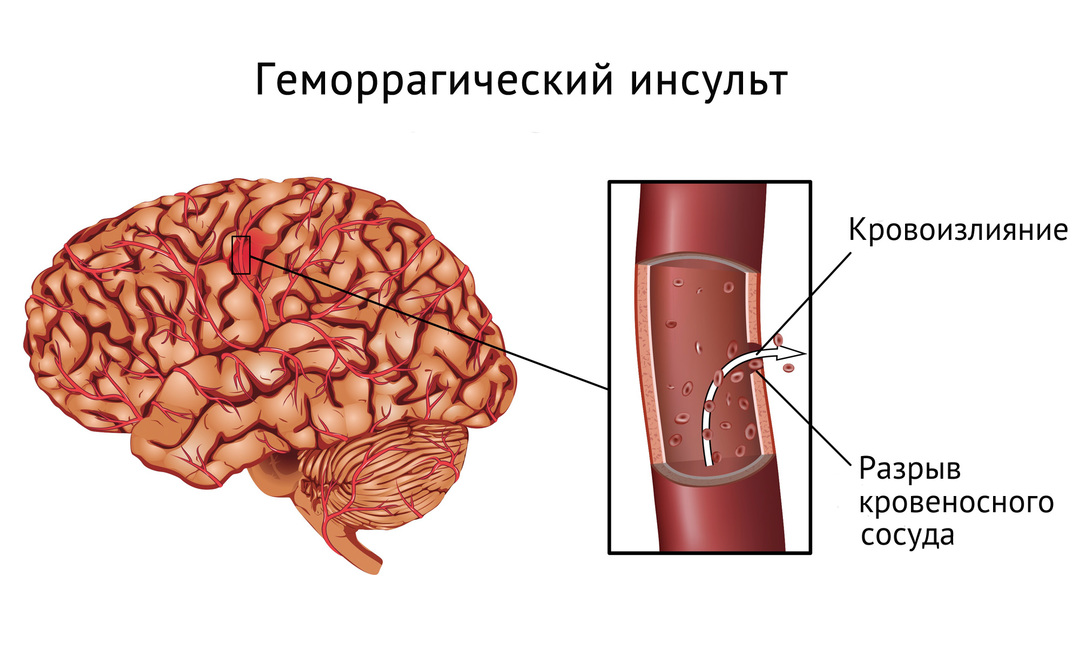
Hemorrhagic may appear due to the following reasons:
- head injuries (impact, falls);
- shake;
- ruptured aneurysm;
- hypertensive crisis;
- rupture of the vessel at the site of the atherosclerotic plaque;
- blood clotting disorders.
With various mechanical injuries, a vessel inside the brain and in the membrane is damaged. The result of this damage is an intracerebral stroke. The complications of this stroke often lead to certain death.
In the case of hypertensive crisis and atherosclerosis, both in men and women, vascular damage occurs due to a strong increase in blood pressure. In a crisis, it can reach up to 200-240 mmHg. This indicator is sufficient to damage the vessel wall. Since the vascular walls in areas of the brain are not strong enough, they are most susceptible to high pressure. The larger the vessel that was damaged, the stronger the consequences can be.
If there was damage to the vessel, and the person has problems with blood clotting, then it is important to take drugs for clotting as soon as possible. If this is not done, then the likelihood of getting a severe stroke is high.
With a severe stroke, treatment can be difficult due to the location of the injury site. Since the brain does not have the function of regeneration, it is not able to renew neurons, and with a significant loss of neuronal cells, the likelihood of the loss of certain body functions increases.
Causes of ischemic stroke
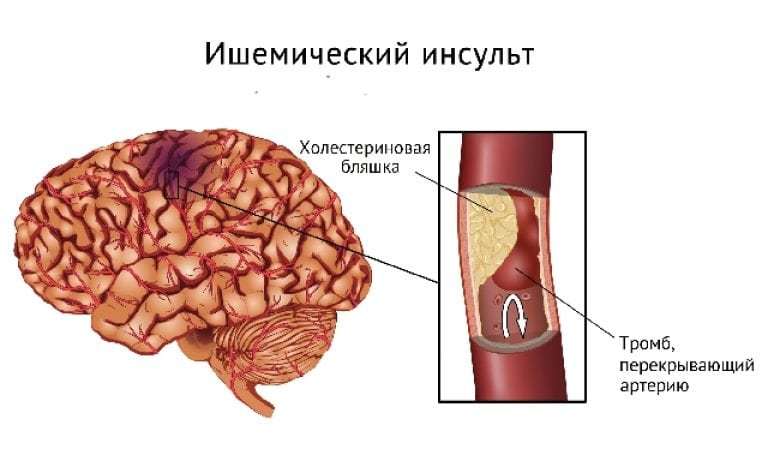
The likelihood of an ischemic stroke is high with such disorders:
- atherosclerosis of the cerebral and carotid arteries;
- thrombosis and embolism of tissues of the left hemisphere;
- gas embolism of blood vessels.
Thrombus and embolus most often provoke ischemic stroke of the brain. If they are in the vessels, then if they are torn away from the wall, they can completely block the artery, which will block the flow of blood to a certain area. The probability that they will enter the brain is 25%.
In the case of atherosclerosis, everything is also serious. If the endothelium of the vessel is damaged at the location of the plaque, then the likelihood of developing the disease is high. Platelets will be deposited at the site of damage to the plaque, they will lead to the fact that the lumen of the vessel is narrowed and in the future can be completely clogged. Overlapping it leads to a stroke.
Read also:Myasthenia gravis - what kind of disease, causes, symptoms and treatment
This can be prevented by preventive methods. They are aimed at increasing the rheological properties of blood and prevent platelet aggregation.
Provoking factors
Dividing the pathology into several types, according to the method of damage, provoking factors come out on top in the development of stroke. The classification looks like this:
- hemorrhagic;
- ischemic;
With a stroke, it is better to differentiate the causes of two types of disease. This is all due to the fact that they have a different mechanism of damage to brain tissue. In hemorrhagic cases, internal bleeding plays a key factor, and in ischemic cases of narrowing or complete overlap of the lumen of the vessel wall, as a result of which the blood ceases to enter the brain tissue. Therefore, the reasons for the predisposing factors that lead to this disease must be sought in the state of the body.
Symptoms
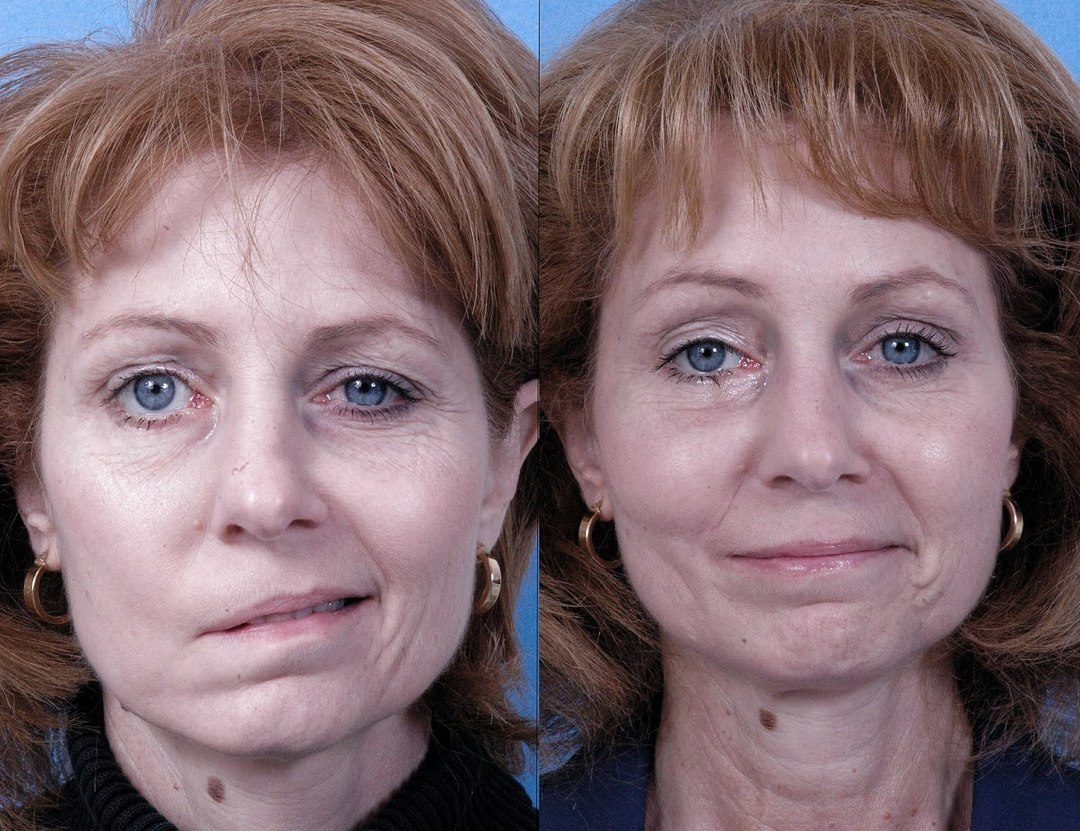
It is important to know that a cerebral stroke is manifested not only in the form of paralysis. Symptoms vary. But the most important thing is to see the signs of the initial stage of a stroke as early as possible and immediately call an ambulance in order to start the treatment procedure as soon as possible. But in some cases, the first signs may not be detected. Such prompt action can help avoid most of the dangerous consequences. Everyone should know the main signs of the manifestation of the disease.
From the school curriculum, everyone knows that each body system is responsible for certain functions in the body, and they obey different parts of the brain. Its structure is structured as follows:
- the cerebral cortex, located on top under the skull. Responsible for thinking, speech, muscle movements, feelings;
- subcortical part. Responsible for the work of: heart, respiratory system, blood pressure;
- the cerebellum is located in the posterior region of the brain. Controls the coordination of movements.
Based on which area was affected by a stroke, one can judge which functions will be impaired in a person. But most often the malfunctioning function occurs in the cerebral cortex. The symptoms of such a violation are as follows:
- movements are disturbed;
- limb strength becomes weaker;
- impaired sense of perception;
- speech impairment;
- inability to stand upright;
- increased feeling of drowsiness;
- loss of consciousness.
Less severe symptoms:
- pain around the circumference of the head, similar to a migraine;
- a feeling of dizziness, similar to those with diseases of the middle ear;
- convulsions.
Dizziness, which is accompanied by vomiting and nausea, is an important factor. If there are no other causes of these pathologies, then in a small percentage of cases, this indicates the presence of a stroke. But most often, this condition indicates a malfunction of the vestibular apparatus and is not dangerous to human life. If such signs have additional violations, then it is important to see a doctor as soon as possible to make the correct diagnosis.
Read also:Bulbar and pseudobulbar syndrome: what is it, photos, causes and treatment of the disorder
The first signs in older women:
- incoherent speech;
- loss of memory;
- lack of emotion.
Periods and stages of the disease
| Periods | Designation |
| Sharpest | It appears during the first day |
| Spicy | Lasts from one day to 3 weeks |
| Subacute | It took from 3 weeks to 3 months since the onset of the stroke |
| Early recovery | Term 3-6 months from the first manifestation |
| Late recovery | From the moment of occurrence, it takes from 6 to 12 months |
| Selected consequences | More than a year has passed since the onset of the disease. |
After a stroke, the best factor in recovery is time. If the disease has not left serious consequences, and it is not in an advanced form, then rehabilitation will be extremely effective.
Diagnostics
In order to diagnose a stroke, it is important to take into account the patient's risk factors and adjective diseases. It is important to get a consultation with a neurologist in the near future. To confirm or deny the diagnosis, it is necessary to carry out the following tests:
- general blood analysis;
- blood chemistry;
- general urine analysis;
- blood coagulogram;
- electrocardiogram;
- vascular dopplerography;
- computed tomography or magnetic resonance imaging;
- consultation with a profiling doctor.
The same tests are taken for men and women.
Treatment
The treatment of this ailment is stationary. At first, the patient is in the intensive care unit, since there is a high probability of a sharp deterioration in the patient's well-being.
In a timely manner, doctors carry out a number of important activities. After confirmation by computed tomography of the presence of an ischemic focus, with the help of special equipment, the blood clot is resorbed under the influence of the drug. There is a control over the vital systems of the body. With help Aspirin or Reopoliglyukin decreases blood viscosity to minimize the occurrence of thrombosis. The use of drugs Cortexin and Nootropics (list of nootropic drugs) makes it possible to start the process of protecting brain cells and actively start the recovery processes.
Upon completion of these procedures, the doctor prescribes medications aimed at minimizing the possibility of a recurrence of a stroke, and which can fight any complications at the end of the disease. It is important to visit a specialist doctor regularly. Implement special measures to support blood pressure and protective function.
Prophylaxis

Looking at the data from the statistics department, you can understand that preventive methods are very important. After all, mortality from a stroke, or rather from its acute period, is equal to 35%, for a year this indicator can rise to 48%, speaking in another indicator, then mortality threatens every second patient to the patient. About 80% of all people who have suffered a cerebral stroke and survived become disabled.
It is important for everyone who has had this disease to regularly come to prophylaxis, since such people have a very high risk of catching a second stroke. A cerebral stroke is not only a disease of aged people, it can befall anyone. Statistics show that more and more cases of strokes are observed among the healthy, able-bodied population under the age of 45. When divided by gender, men have a higher rate of stroke at this age than women.
Read also:Subarachnoid hemorrhage
Having looked at the list of factors that provoke the appearance of the disease, then everyone can find one such factor. Some "lucky ones" may even have several reasons. What to do in this case? It is very important not to start to panic. The main thing is to weigh everything with a cool head. You need to sit down and think about your lifestyle, habits, and taking care of your body. The best option would be to refuse or at least minimize the abuse of bad habits:
- to give up smoking;
- start playing sports;
- do not eat too much;
- do not drink strong alcoholic beverages;
- from time to time monitor the level of blood pressure, as well as the content blood glucose and an indicator of cholesterol.
All this is not just a waste of time, it is, first of all, taking care of your health and life in general. Wasted time will not be ineffectual. The result will be a strong and healthy future. There is no need to try to radically change everything at once, you need to go towards the goal smoothly and gradually.
Recovery period
The final stage of treatment is the recovery process. It consists of a number of essential integral parts for returning to a satisfactory level of performance. In men, the recovery time may be slightly faster than in women.
First of all, you need to go through the process of neurorehabilitation. It is represented by a set of activities that are carried out only under the supervision of various specialists in a specially designed medical institution, such as sanatoriums and dispensaries. It is imperative to visit doctors involved in medical physical culture, it is necessary to deal with them from the second day of the onset of the disease. It is very important to start all attempts to get up as early as possible. If the ischemic form, then after 5 days, if hemorrhagic, then after 14-21 days.
A speech therapist will take over the process of restoring normal speech. The neuropsychologist will assess the general level of memory and intelligence, after which he will prescribe recommendations for restoring these abilities. Working with a physical therapist will properly stimulate the nervous system. A specialist psychotherapist will help you get rid of the feeling of being unnecessary, discouraged and unsettled.
In the case during the initiated active part of the neurorehabilitation process, most cases have a chance of high success. The functions lost by the body will be restored quickly and to the fullest extent possible, which will return a person to society.

